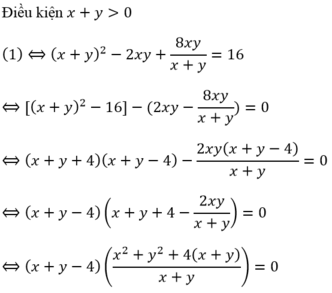x2 - 3.x.y + 3.y - x = 1
Hãy nhập câu hỏi của bạn vào đây, nếu là tài khoản VIP, bạn sẽ được ưu tiên trả lời.


a: \(\left(x,y\right)\in\left\{\left(1;-2\right);\left(-1;2\right);\left(-2;1\right);\left(2;-1\right)\right\}\)
b: \(\left(x,y\right)\in\left\{\left(-3;1\right);\left(-1;3\right)\right\}\)
d: \(\left(x,y\right)\in\left\{\left(1;-11\right);\left(-11;1\right);\left(-1;11\right);\left(11;-1\right)\right\}\)

a, \(xy=5\)hay \(x;y\inƯ\left(5\right)=\left\{\pm1;\pm5\right\}\)
| x | 1 | -1 | 5 | -5 |
| y | 5 | -5 | 1 | -1 |
c, \(\left(x+1\right)\left(y-5\right)=-5\)hay \(x+1;y-5\inƯ\left(-5\right)=\left\{\pm1;\pm5\right\}\)
tự lập bảng, tương tự với mấy bài khác chỉ khác nó có điều kiện thì xét nó rồi kết luận nhé!

Sửa đề: Các dấu bằng ở yêu cầu là dấu cộng.
1. Có: \(x+y=3\)
\(\Leftrightarrow\left(x+y\right)^2=3^2\)
\(\Leftrightarrow x^2+2xy+y^2=9\)
\(\Leftrightarrow x^2+y^2=9-2\cdot1=7\) (do \(xy=1\))
\(------\)
Lại có: \(x+y=3\)
\(\Leftrightarrow\left(x+y\right)^3=3^3\)
\(\Leftrightarrow x^3+y^3+3xy\left(x+y\right)=27\)
\(\Leftrightarrow x^3+y^3+3\cdot1\cdot3=27\) (do x + y = 3; xy = 1)
\(\Leftrightarrow x^3+y^3=18\)
Ta có: \(x^2+y^2=7\)
\(\Leftrightarrow\left(x^2+y^2\right)^2=7^2\)
\(\Leftrightarrow x^4+y^4+2\cdot\left(xy\right)^2=49\)
\(\Leftrightarrow x^4+y^4=49-2\cdot1=47\) (do xy = 1)

phương trình nghiệm nguyên kiểu này liệt kê ước rồi kẻ bảng ra nhé

Bài 1:
a, \(x^2\) +2\(x\) = 0
\(x.\left(x+2\right)\) = 0
\(\left[{}\begin{matrix}x=0\\x+2=0\end{matrix}\right.\)
\(\left[{}\begin{matrix}x=0\\x=-2\end{matrix}\right.\)
\(x\) \(\in\) {-2; 0}
b, (-2.\(x\)).(-4\(x\)) + 28 = 100
8\(x^2\) + 28 = 100
8\(x^2\) = 100 - 28
8\(x^2\) = 72
\(x^2\) = 72 : 8
\(x^2\) = 9
\(x^2\) = 32
|\(x\)| = 3
\(\left[{}\begin{matrix}x=-3\\x=3\end{matrix}\right.\)
Vậy \(\in\) {-3; 3}
c, 5.\(x\) (-\(x^2\)) + 1 = 6
- 5.\(x^3\) + 1 = 6
5\(x^3\) = 1 - 6
5\(x^3\) = - 5
\(x^3\) = -1
\(x\) = - 1

b) Ta có: xy=-3
nên x,y là các ước của -3
\(\Leftrightarrow\left[{}\begin{matrix}\left\{{}\begin{matrix}x=-1\\y=3\end{matrix}\right.\\\left\{{}\begin{matrix}x=-3\\y=1\end{matrix}\right.\\\left\{{}\begin{matrix}x=3\\y=-1\end{matrix}\right.\\\left\{{}\begin{matrix}x=1\\y=-3\end{matrix}\right.\end{matrix}\right.\)
Vậy: \(\left(x,y\right)\in\left\{\left(1;-3\right);\left(-1;3\right);\left(-3;1\right);\left(3;-1\right)\right\}\)




\(x^2-3xy+3y-x=\)\(1\)
\(\Leftrightarrow\left(x^2-x\right)+\left(-3xy+3y\right)=1\)
\(\Leftrightarrow x\left(x-1\right)-3y\left(x-1\right)=1\)
\(\Leftrightarrow\left(x-1\right)\left(x-3y\right)=1\)
+) \(\hept{\begin{cases}x-1=1\\x-3y=1\end{cases}}\)\(\Rightarrow\hept{\begin{cases}x=2\\x-3y=1\end{cases}}\)\(\Rightarrow\hept{\begin{cases}x=2\\y=\frac{1}{3}\end{cases}}\)
+) \(\hept{\begin{cases}x-1=-1\\x-3y=-1\end{cases}}\)\(\Rightarrow\hept{\begin{cases}x=0\\x-3y=-1\end{cases}}\)\(\Rightarrow\hept{\begin{cases}x=0\\y=\frac{1}{3}\end{cases}}\)
Vậy (x;y)= (2;1/3 ) ,(0; 1/3)
\(\Rightarrow\orbr{\begin{cases}\hept{\begin{cases}x-1=1\\x-3y=1\end{cases}}\\\hept{\begin{cases}x-1=-1\\x-3y=-1\end{cases}}\end{cases}}\)